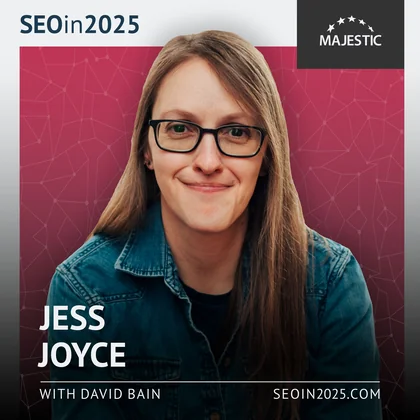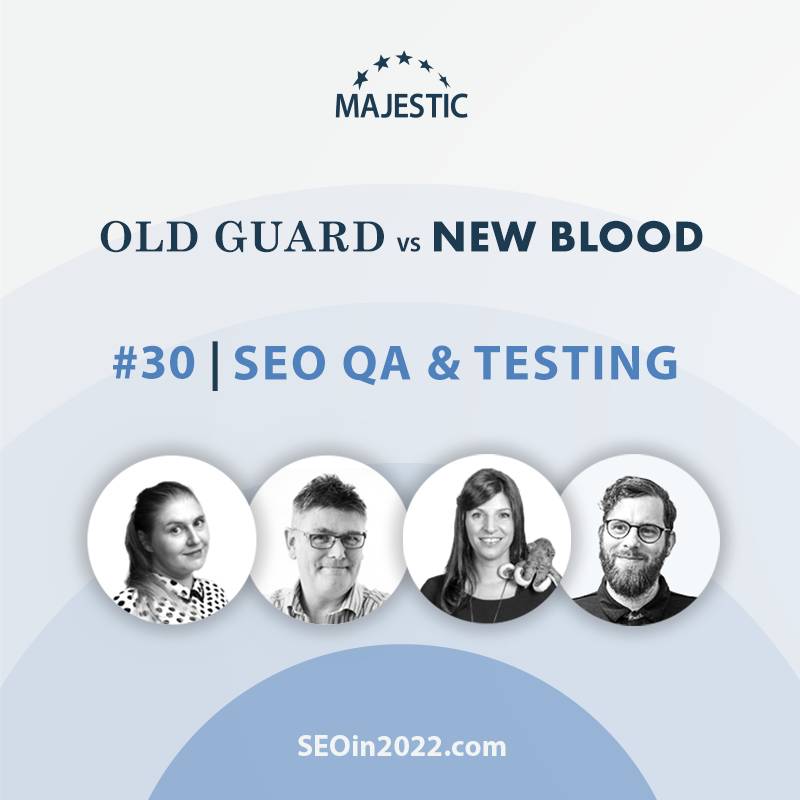-
Site Explorer
- Majestic
- Summary
- Ref Domains
- Backlinks
 New
New Lost
Lost- Context
- Anchor Text
- Pages
- Topics
- Link Graph
- Related Sites
- Advanced Tools
- Author ExplorerBeta
- Summary
- Similar Profiles
- Profile Backlinks
- Attributions
- Compare
-
Link Tools
- My Majestic
- Recent Activity
- Reports
- Campaigns
- Verified Domains
- OpenApps
- API Keys
- Keywords
- Keyword Generator
- Keyword Checker
- Search Explorer
- Link Tools
- Bulk Backlinks
- Neighbourhood Checker
- Submit URLs
- Experimental
- Index Merger
- Link Profile Fight
- Mutual Links
- Solo Links
- PDF Report
- Typo Domain
- Free SEO Tools
- Support
Discover your prospects’ questions to answer them before they are asked
Jess Joyce
SEO Consultant Jess Joyce is another expert who is putting their focus on exactly what your ideal customer needs, instead of trying to be all things to all people all of the time.

Discover your prospects’ questions to answer them before they are asked
Jess says: “Integrate your prospects’ questions into your content to ensure that you’re answering what they’re looking for before they need it.”
How do you know who your prospects are?
“Most of the companies we work with have ICPs (Ideal Customer Profiles), that they’re looking to target in some way. You’re not targeting everyone because, if you’re targeting everyone, you’re targeting no one.
At the end of the day, you need to know who you’re targeting, and those people will have questions before they are converted to a lead, MQL, SQL, etc. Most of the companies that we work with have sales teams, and these sales teams have endless questions that people are asking.
We’ve been doing a lot of work with answering those questions on the website, before they get to the sales teams. Users are highly educated and internet-savvy now, so they can answer these questions themselves. People don’t want to talk to a sales team unless they’re at the qualification stage and pushing the big red button.
Why not answer those questions before they even have to talk to a salesperson?”
How do you find out what these questions are?
“Understanding their needs and pain points is 100% part of the game. This is a little bit less like traditional SEO, but it very much is SEO. It doesn’t involve as much keyword research, although that does come into it too. If your product is commoditised enough that people are looking for it at any other level, then that might still be valuable.
We use a lot of sales recordings, like Gong or any other transcription service. You take all of that information and craft your prospects’ pain points, questions, and needs. You can then pull that out and use it to create content for the website that is very informational and helpful to anyone who’s looking for your product.
If you haven’t used Gong, it is like a transcription service for sales. It uses an ‘AI’ to summarise and analyse your sales recordings, and it pushes that information around to the right parts of the sales organisation. It’s incredibly helpful. You can take that information and organise it in a way that’s helpful to SEO.”
How do you know you’re answering the right questions?
“That’s why you take the sales recordings. If you’re using keyword data, the intent doesn’t always match your ICP, the user you’re targeting, your business needs, the onboarding documents, and everything else that’s going on around your product.
If you use sales recordings, then you know that a prospect is actually looking for an answer to that question from somewhere in the sales funnel. It gives you more intent than something that’s coming out of traditional keyword research. You can’t exactly quantify it with a number for volume, but you can quantify it because it’s closer to your needs set.
Take every conversation that your sales team – and even your customer service team – has, put it into a tool like Gong, and get it to make sense of it. See where the questions are, what the repetitions are, and then come up with an ordered list of questions from there. Then you can turn those into the best possible content to answer your searchers’ questions.
FAQs, service pages, feature pages, use cases, blogs, YouTube videos, Shorts, TikTok videos, etc. The list of what you can create is endless. A lot of companies do really wonderful work with their product teams and having someone answer those questions on a YouTube channel before their prospects even convert to leads.”
Could you create your own custom GPT to do this specific task?
“We may have done that. Stay tuned.”
Are there any legal issues with taking data from conversations with customers or do you just need to make customers aware that calls may be recorded?
“That is important. Gong has its own level of legal compliance that the users will go through. Whenever they have those sales calls, a little thing comes up that asks the user to authorise that they are being recorded. Most of these AI transcription services will do the same thing.
It is compliant with GDPR, CPPA, and other data privacy laws. It is definitely above board as far as the legalities go.”
How do you focus on the data that’s more likely to be more useful for the business?
“We end up doing a lot of scanning through those conversations, which is where that custom GPT comes in. There’s a wonderful human out there, Steve Toth, who uses regex to find questions that are helpful to the business. We’ve taken that concept and applied it to this use case.
He takes a regex of who, what, where, when, why, and a bunch of other things that are important in the conversations. You can scroll through these conversations to find the appropriate information and take that out of there, which is essentially what the GPT does.
It will mostly find commonly asked questions, and then I usually do a precautionary peruse of the entire set just to make sure that we’re getting everything out of there. It’s not perfect by any stretch of the imagination, which is why we haven’t released anything yet.
Ideally, it spits out the most commonly asked questions. A bunch of sales data tools and CRMs do this too. We have a customer who’s doing this with Asana at the moment, and they’re surfacing the best questions that are coming out of their sales teams too. There are different ways to slice it, this is just one use case for it.”
Is the frequency that questions are asked the best way to determine the best questions?
“Yes, it’s like a different way of doing keyword research. If you can put a number to it, then you can put value to it, and you can get buy-in from your organisation. You can say that 5 people have asked this question, so you should answer it before they get to the other teams. It helps sales out, it helps integration out – it helps everyone out.
It means that sales can also point to the website (because sales always want more information on the website). Then you’re building your FAQs, and you’re building your answer engine to feed into the search engines and the AIs too.”
Can you take data from other sources as well?
“100%. This is limitless. Sales data is just the first use case that we’ve tried this for, just because it is the most established that we’ve seen throughout various organisations. Since we work with B2B SaaS, a lot of them already have this flow in place.
This could be used in any scenario. Take away the idea of traditional keyword research and you can build your own keyword research out of this for your own use cases and your own ICPs, which we’ve found to be endlessly beneficial.”
What does the content production process look like?
“That’s when it gets really fun, in my opinion, because then you can talk to your internal stakeholders and figure out what their pipelines are, what they’re looking to publish, and what they have the capacity to publish.
That can turn into any kind of content, whether it be competitor content, comparison content, etc. We have a client who’s comparing the old way of doing things to the new way of doing things because of this. You can create use case feature pages, FAQ pages, About pages – we could go on and on.
In my dream scenario, this would be bubbled up to the homepage so that people would get their information right out of the gate and be able to click that button to get started. However, homepages usually have a lot more stakeholders than just SEO. It will be a longer trial before we get there.”
How do you measure the impact of what you’re doing here?
“We measure it the same way that we measure everything: leads, conversions, people staying on the site longer, people pushing more buttons – doing all those wonderful things that they do.
Most of the companies that we work with have multiple ways that people are testing conversions. Then we make our own data and dashboards for things – Databox, Looker Studio dashboards, etc. – for all these metrics that come through.
The long tail SEO game of capturing somebody before they want something from you still exists, but these questions don’t really have any keyword search volume anymore. You’re creating that demand by answering those questions. It’s the same game, I’m just moving in a different way and it’s a different application. You’re targeting the top of the funnel, but you’re targeting zero volume keywords instead of high-volume keywords.
The only pushback we get is that it takes a long time to get this information out of the hands that it’s currently sitting in. It’s usually something that we don’t do for the first 2 months, just because we have to wait for everybody to understand what we’re doing and outline the process as clearly as possible. Once we do get access, it’s wonderful and people are really happy with the results.”
If an SEO is struggling for time, what should they stop doing right now so they can spend more time doing what you suggest in 2025?
“Stop writing meta description tags, for the love of cheese and crackers. I love a meta description tag but move to the money. Google rewrites that stuff around 70% of the time these days anyway. You can maybe write them for your highest-traffic pages but if you have thousands of blogs, just don’t. Leave it at the doorstep.
I wouldn’t even use AI to produce them. The intent of some of those bottom-of-funnel pages is so mixed and all over the place that you can honestly just let Google decide at that point.
Once it starts getting traffic, you might be more likely to rank prominently if it has a meta description. You can use automation to take a phrase from your body content and use that, and you can do the same with your alt tags at this point too. Automation is very helpful for that.
However, I’ve seen a few people try to get buy-in to refresh all their meta descriptions, which is just a nonsense project. Move to the money, which is where you can move upstream, get more buy-in, and make your clients happier in the long term.”
Jess Joyce is an SEO Consultant, and you can find her over at JessJoyce.com.
Also with Jess Joyce
Choose Your Own Learning Style
 Video
Video
If you like to get up-close with your favourite SEO experts, these one-to-one interviews might just be for you.
Watch all of our episodes, FREE, on our dedicated SEO in 2025 playlist.
 Podcast
Podcast
Maybe you are more of a listener than a watcher, or prefer to learn while you commute.
SEO in 2025 is available now via all the usual podcast platforms
Don't miss out
Opt-in to receive email updates.
It's the fastest way to find out more about SEO in 2025.
Could we improve this page for you? Please tell us







